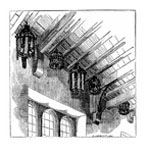
Reading Lettered Ecosystems
HILL COUNTRY EAST OF BETHEL — PART I
I used to live in Berkeley. Not so much the Berkeley of the 1964 Free Speech Movement or the Berkeley that Jimi Hendrix played on Memorial Day in 1970, a year after the fatal shooting of a student protester at People’s Park. Or the Berkeley of Dale and Elena Vree’s counter-counter-countercultural New Oxford Review, or even the Berkeley that George Santayana addressed in 1911 when, in the city’s first incendiary speech act, the Spanish philosopher turned his back on Harvard (his employer), delivered a sly critique of the American “genteel tradition,” and left for Rome, never to return.
I mean, rather, the Berkeley of Bernard Maybeck and Bay Tradition architecture, which crossed the natural-wood “craftsman” look with an emphasis on industrial materials, Prairie School horizontality, and Beaux-Arts classicism. I mean the Berkeley of poet William Everson, a.k.a. Brother Antoninus, who ran a letter press in the basement of St. Albert’s Priory in Oakland after doing time at an internment camp for pacifists in Oregon, and who wrote in his spare time about ravens “sloping above the lonely fields” and cawing on “the farthest fences of the world.”
I mean the Berkeley where the owner of every other Queen Anne “brown shingle” rented out a cottage in the back yard to a card-carrying bohemian like Allen Ginsburg, who lived on Milvia Street while preparing for the 1955 Gallery Six poetry reading, or his buddy Gary Snyder, who faced the Far East, slept on a straw mat, and read by the light of a kerosene lamp while living on Hillegass Avenue. I mean the Berkeley of radio station KPFA’s Pauline Kael, who “lost it at the movies” almost every single week while writing for The New Yorker; the Berkeley of filmmaker Les Blank and his friends over at Arhoolie Records, keepers of the flame before the altar of “raw” folk expression, be it zydeco, scratchy Lemon Jefferson blues, or steel drums; the Berkeley of Christopher Alexander, whose “pattern language” in the key of southern France guided the construction of Apple Computer as well as livable houses in pedestrian-friendly neighborhoods.
Most of all, I mean the Berkeley whose leading lights thought in terms of “meanders” and “rhizomatic structure” and “bee swarms” when it came to explaining social reality, and so helped to hatch the idea of “city-nature” (the West Coast version of Jane Jacobs’s New Urbanism) and various “re-wilding” projects like uncovering creeks hidden by city pavement or building lettuce farms in factory districts.
You May Also Enjoy
We need an overall increase in knowledge of the Catholic religion among all age groups in each diocese, in particular as concerns the sacraments.
The conceit of the Enlightenment was that we could have the good of Christendom without the Church. “Judeo-Christian Westernism” assumes this.
National Catholic Reporter tries to put a good face on a serial pederast.

